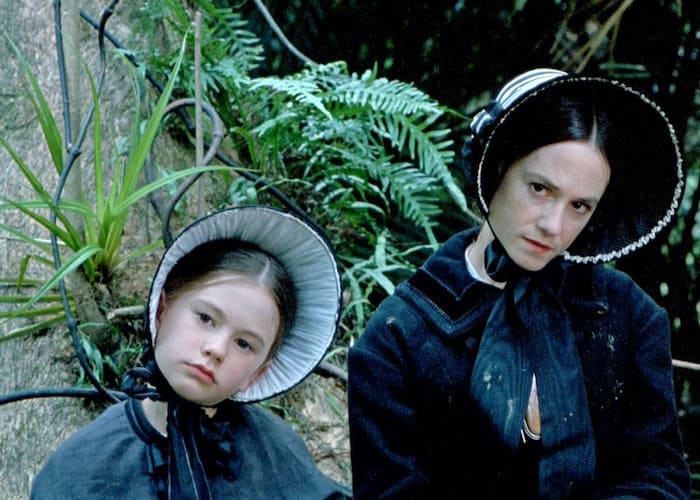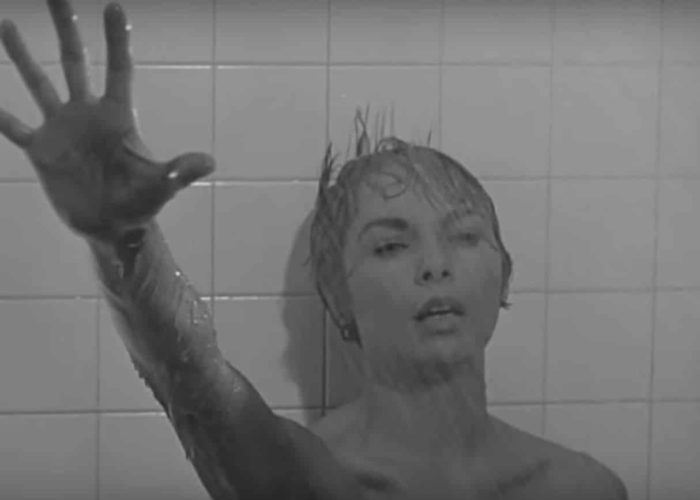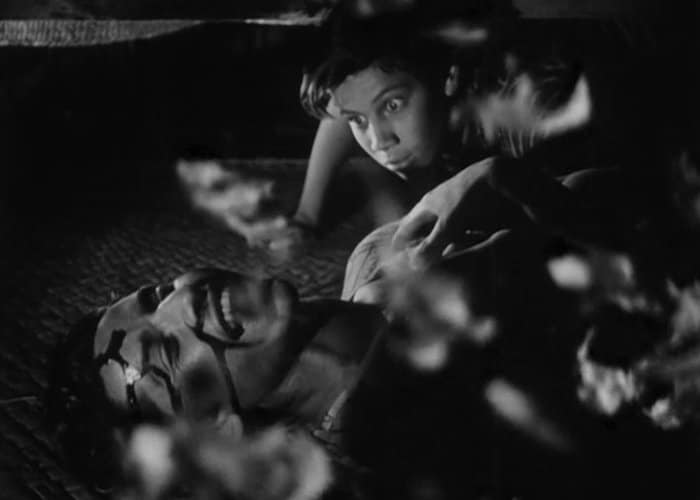Whatever way you want to view it, whether theatrically or streaming in one sitting on Netflix or broken up into sections when you have the time, you must watch Martin Scorsese‘s The Irishman. The 209-minute historical gangster epic is really the filmmaker’s last word on the genre he’s most associated with, and it’s a satisfying piece of cinema on a multitude of levels. To achieve such a work, Scorsese owes a lot to certain masterpieces of the past. And ever the cineaste, he’s not shy about discussing those influences. Below I’ve compiled the titles he has cited in order to recommend them as further suggested viewing. And I’ve also added some personally selected picks that go well with his latest.
Rolling Thunder Revue: A Bob Dylan Story by Martin Scorsese (2019)

Scorsese is having quite a year. He inspired one of the highest-grossing movies of 2019 (Joker) and executive-produced one of the best movies of 2019 (Uncut Gems) and he also directed one of the best nonfiction features of 2019. Nominated for multiple Critics’ Choice Documentary Awards, Rolling Thunder Revue is difficult to define. Like The Irishman, the fellow Netflix Original is based on a true story but contains a lot of fictional or disputable details. Bob Dylan is a mythmaking unreliable narrator same as Frank Sheeran. Some of the characters aren’t real. Some of the real people, such as Sharon Stone, aren’t really part of the history being shared. And a lot of the material is manipulated, especially in the contexts being presented. However, the archival concert footage, shot during Dylan’s Rolling Thunder Revue tour in the mid-’70s, is authentic and amazing, and the film does document a perspective and feeling of the events both remembered and captured more than 40 years ago.
Stream Rolling Thunder Revue: A Bob Dylan Story by Martin Scorsese on Netflix
Casino (1995)

Speaking of Sharon Stone, here’s a movie for which she received an Oscar nomination. I’ve recommended Scorsese’s 1990 gangster classic Goodfellas plenty of times in these Movies to Watch After lists, but Casino doesn’t get a lot of love because it’s not thought of as an influence on modern crime films the same way. In addition to being the filmmaker’s last feature directorial collaboration with either Robert De Niro or Joe Pesci before The Irishman, Casino is also his last historical gangster picture in the vein of Goodfellas and the new movie at hand. Most of the characters here are fictionalized, however, including the Alan King role of Andy Stone, who is based on Jimmy Hoffa associate Allen Dorfman, portrayed in The Irishman by Jake Hoffman. Also, the late comedian Don Rickles has a major supporting role in Casino and is now portrayed by Jim Norton in The Irishman and the late singer Jerry Vale plays himself in Casino (and Goodfellas) but is portrayed by Steven Van Zandt in The Irishman. I also recommend The Good Shepherd (2006), which De Niro directed and features the previous reunion between him and Pesci while also dealing with fictionalized versions of famous gangsters and political figures that overlap with The Irishman.
The Piano (1993)

There are plenty of movies to recommend for past groupings of actors from The Irishman, from Mean Streets to Heat. The Piano counts because it stars both Harvey Keitel and Anna Paquin. But the main reason for its inclusion here is because of the criticisms about Paquin’s role in The Irishman. It’s the same thing that happened earlier this year with Margot Robbie in Once Upon a Time…in Hollywood. The actresses don’t have a lot of lines. But that doesn’t mean they’re slight roles or weak performances. As Peggy Sheeran, Paquin’s silence is significant. Let’s not forget that for decades actors delivered performances without any possibility for dialogue. Also, let’s not forget about Holly Hunter’s Oscar-winning performance in The Piano as a mute woman. Paquin also won an Oscar for this movie at age 11 as the woman’s daughter and interpreter. The Piano also was just named the greatest film directed by a woman.
Rent or buy The Piano from Amazon
Hoffa (1992)

The Irishman isn’t a biopic about Jimmy Hoffa, but the famous Teamster leader does play a major part in the story. Hoffa has been portrayed a number of times in the past. Most notably, Robert Blake played him in the 1983 miniseries Blood Feud, which goes deeper into his battles with Robert Kennedy, and Jack Nicholson played him in the David Mamet-scripted and Danny De Vito-helmed biopic Hoffa. Al Pacino is sure to follow in their shoes and be the third actor nominated for a Golden Globe for the part. And here’s another fun fact: both Scorsese and De Vito have the same birthday, November 17th. In Hoffa, the titular labor icon is seen gunned down by an unknown hitman played by Frank Whalley, though at the time Hoffa’s death and disappearance were still a total mystery. Sheeran wouldn’t claim to have been the killer until a decade later, on his deathbed. Even that’s not confirmed, though. In the 2018 Fox TV documentary Riddle: The Search for James R. Hoffa, the FBI offered a statement of “no comment” when asked about their recent DNA tests to determine what happened and whodunnit.
JFK (1991)

Oliver Stone, who was originally supposed to direct Hoffa, helmed this masterwork of conspiracy theory mythology. While The Irishman also makes claims about the assassination of John F. Kennedy, that story is also still an open book as far as the truth goes. When JFK was made, theorizing about what actually happened at Dealy Plaza on November 22, 1963, was at its highest peak since Jim Garrison’s investigation throughout the 1960s following the official results of the Warren Commission. Kevin Costner portrays Garrison in this depiction of that investigation, and there are interesting overlaps with The Irishman such as the latter’s reference to David Ferrie, who is played in JFK by Joe Pesci. Scorsese’s movie is a straightforward telling of history, including the Bay of Pigs invasion and the deaths of the Kennedys, from a sole unreliable narrator. JFK is an unsolvable puzzle representing the enigmatic search for truth in the president’s murder.
The Shootist (1976)

Seen on a marquee in a scene in The Irishman, The Shootist is the final movie starring John Wayne, who died a few years later. It’s a perfect movie for Scorsese to nod to because it’s about an old man reflecting on his life within the context of a climactic entry of a prominent movie genre. In The Irishman, De Niro plays a real man looking back at his life of crime and historical events that figure into and inspired many other crime films, including some starring De Niro in his younger days. The Shootist features clips of Wayne in his younger days starring in classic Western films. Both actors are really associated with the respective genres. A number of reviews of The Irishman have pointed out the “Easter egg” referencing The Shootist and acknowledge the link between the movies as far as their dealing with characters in times of reckoning and their genre eulogizing. Scorsese has made connections between gangster films and Westerns before, most memorably with the final shot of Goodfellas paying homage to the final shot of The Great Train Robbery (1903).
Stream The Shootist on Amazon Prime Video
Le Doulos (1962) and Le Deuxième Souffle (1966)

Ahead of the theatrical release of The Irishman, Scorsese was interviewed by fellow filmmaker and New York cinema icon Spike Lee. Part of their conversation covered the movies that influenced Scorsese’s new movie, and The Film Stage relayed a number of quotes from that event. A couple of the films mentioned are by French crime film master Jean-Pierre Melville, including the heist film Le Doulos (aka Doulos: The Finger Man) and the gangster flick Le Deuxième Souffle (aka Second Breath). Both follow criminals just out of prison, though the character is released in the former and an escapee in the latter. Scorsese says that he showed them to his director of photographer, Rodrigo Prieto, not for visual reference but for the tone of the new film.
“The tone of the movie, it had to be contemplative and an epic, but it had to be an intimate epic. I showed a couple of Jean-Pierre Melville films, ‘Le Doulos’ and ‘Le Deuxième Souffle,’ with Jean-Paul Belmondo [in the latter], both of those pictures. It’s a very different world, but I liked the understatement of it.”
Stream Le Doulos on Kanopy
Stream Le Deuxième Souffle on The Criterion Channel
Psycho (1960)

What does Alfred Hitchcock’s horror classic have to do with The Irishman? Besides the fact that they’re both about murderers, the story of Norman Bates dressing up as his mother and slashing a woman in the shower isn’t the most obvious of influences. But Psycho informed the sound of Scorsese’s new movie. Here’s what he told Spike Lee and their audience at the DGA Theater last month:
“I made choices to take most of the music out anyway, because of the methodic nature of who he is, Frank, and once he has to do this terrible thing, we want to see him go step by step with it. Take them all the way through, the way he feels when he’s doing it. One has to be so careful with film music. Very often it tells you how to feel. But what if you just are uncomfortably watching this guy? He takes his glasses off, gives it to Joe, gets in the plane. There’s no music when the plane takes off. It’s an air of finality that we have to witness this, the way it happens, and then witness after. There’s a wonderful thing, the clean-up scene after the shower scene in ‘Psycho.’ I mean, there’s Bernard Herrmann music there, but there’s something about when we first saw that film at the DeMille theater in the first week in a midnight screening, everybody’s screaming, the fact that we’re back in there. He’s just killed the lead of the movie and he’s cleaning up. What are we watching? The quotidian nature of it. I thought the whole last hour of the picture should be that way. That’s why a lot of the music was pulled away.”
Inside the Mafia (1959)

There are so many famous and semi-famous gangsters in The Irishman, whether they’re major characters or just briefly shown as extras (typically credited with a caption noting their cause of death) or assassination victims. One of the most well-known mob hits of all time is depicted in Scorsese’s film, that of Albert Anastasia (Gary Pastore) in the barbershop of the Park Sheraton Hotel. Two years after that real incident, the film noir B-movie Inside the Mafia opened with a barbershop-set shooting modeled on Anastasia’s killing and the movie is then loosely based on the historic gangster summit known as the Apalachin Meeting.
Other movies worth seeing for Irishman crossovers include Kill the Irishman (2011), in which Paul Sorvino plays Anthony “Fat Tony” Salerno (played by Domenick Lombardozzi in The Irishman), Legend (2015), in which Chazz Palminteri plays Angelo Bruno (Harvey Keitel in The Irishman), and a double feature of The Gang That Couldn’t Shoot Straight (1971), in which Jerry Orbach plays a fictionalization of Joe Gallo (Sebastian Maniscalco in The Irishman) [Fun fact: Orbach was with Gallo at the Copacabana the night of the gangster’s murder] and Crazy Joe (1974), in which Peter Boyle plays Gallo through to his death at the clam house. There’s also the upcoming Mob Town, which I haven’t seen, that not only deals with the Apalachin Meeting but also stars Gary Pastore as Albert Anastasia, making it almost like a genuine spinoff of The Irishman.
Stream Inside the Mafia on Amazon Prime Video
Rififi (1955)

“Another one was Jules Dassin’s Rififi,” Scorsese says in the interview. “There was a period there where a lot of those films were coming over here.” He doesn’t get into how this relates to or influenced The Irishman, but it’s clear between Rififi and the Melvilles and the next entry in this list that Scorsese was just focused on French crime films, even those by American directors in exile after being blacklisted. Dassin also co-stars in Rififi as one of a foursome of criminals (one of which, of course, is newly out of prison) who attempt an “impossible” jewel heist. The act itself is depicted long and slow and silent and has become one of the most influential of its kind, echoed in many movies since. The heist has also been copied by real-life criminals, as well.
Buy the Criterion Collection Blu-ray of Rififi from Amazon
Grisbi (1954)

Another French crime film, Touchez Pas au Grisbi — or simply Grisbi — seems to have been a big inspiration for Scorsese gangster pictures through the years and influenced a number of elements of The Irishman. In the quote below he mentions how Jean Gabin in Grisbi inspired the performance and direction of De Niro in Casino, but look at Gabin in this movie and you’ll also see a resemblance to De Niro in The Irishman. Maybe he’s a mix of De Niro and Robert Mitchum (now, there’s a good tie-in to Scorsese’s Cape Fear remake, too). Here’s Scorsese on Grisbi in conversation with Spike Lee:
“Then I showed a film called ‘Touchez Pas au Grisbi,’ which means ‘Don’t touch the loot,’ which is a very famous early ’50s French gangster film with Jean Gabin. When I was shooting Bob in ‘Casino,’ I felt he was taking on the stature of a late-to-middle-age Gabin. He had a lot of power to him but he had a serenity to him, too, and a coolness. Bob, I felt, was getting that way in ‘Casino.’ ‘Grisbi’ has a similar [theme] in the sense that they are older gangsters in Paris and they are getting involved in stuff they don’t want to get involved with. It’s really the tone, but I like the Gabin feeling of his deportment, how he presented himself. In fact, we used some of the harmonica music from ‘Grisbi’ in the film and Robbie Robertson did the harmonica based on the French noir music of the early ’50s [including ‘Rififi’].”
Los Olvidados (1950)

The earliest film cited by Scorsese is Luis Bunuel’s Los Olvidados (aka The Young and the Damned), from the filmmaker’s Mexico period. Also a crime film, it’s set in the slums of Mexico City and concerns young criminals — one of them, like those in the French films above, is recently out of detention (albeit the juvenile kind). Scorsese brings up this one while discussing one of the cameras used to shoot The Irishman, particularly for slow-motion sequences. He probably could have named any early example of film employing the effect but Los Olvidados specifically seems to have stuck with him the most from his youth.
“That slow motion is a Phantom; the camera is a Phantom. I’ve been obsessed with slow-motion since I can remember, since I first saw films. I guess for me, the slow-motion dreams in ‘Los Olvidados’ are something that stayed with me for a long time. I love the way that people’s expressions change and the movement of the flesh on the arms. That sort of thing. It’s very, very high speed this camera, Phantom. I felt like it would be only two places: the Joe Colombo shooting in Columbus Circle and the wedding itself. Because the wedding is a funeral. And the Colombo thing gave me a chance… There’s something about… people laugh, ‘Oh, mob hits, and that sort of thing,’ but the pain of it, the suffering of all the people around, you see all their faces. You see the family, the wife screaming. You see the hands grabbing the gun. It’s almost like Biblical tableaus that I was going for. I think that camera gave it to me, but one has to be quite sparing with it, and I like the trance-like effect.”
Stream Los Olvidados on Amazon Prime Video
The Black Hand (1906) and The Musketeers of Pig Alley (1912)

The Irishman appears to be Scorsese’s final word on the genre he’s mostly associated with, so here are two of the first words on gangster cinema. The Black Hand (aka The Black Hand: True Story of a Recent Occurrence in the Italian Quarter of New York) is a one-reeler by Wallace McCutcheon for the Biograph Company and like The Irishman begins with characters involved in the meat industry. It’s focused on the victims of gangster-related crimes, which are ultimately dealt with by the police. Hardly the sort of story the genre wound up romanticizing. D.W. Griffith’s The Musketeers of Pig Alley is also a one-reeler but a little bit longer and is considered one of the last significant works of that format before Griffith and others began making features shortly afterward. The Musketeers of Pig Alley is, more than The Black Hand, considered the kickoff of the genre, perhaps because while it focuses on victims of criminals at first, it then deals with rival crime organizations in a gang war mostly set in the Lower East Side of Manhattan. Also, the main gangster is let off the hook at the end. And maybe real gangsters played extras. As a result of its cultural significance, it was added to the National Film Registry a few years ago.
Stream The Black Hand via Wikipedia Commons
Stream The Musketeers of Pig Alley via Wikipedia Commons
The post Watch ‘The Irishman,’ Then Watch These Movies appeared first on Film School Rejects.
0 comments:
Post a Comment